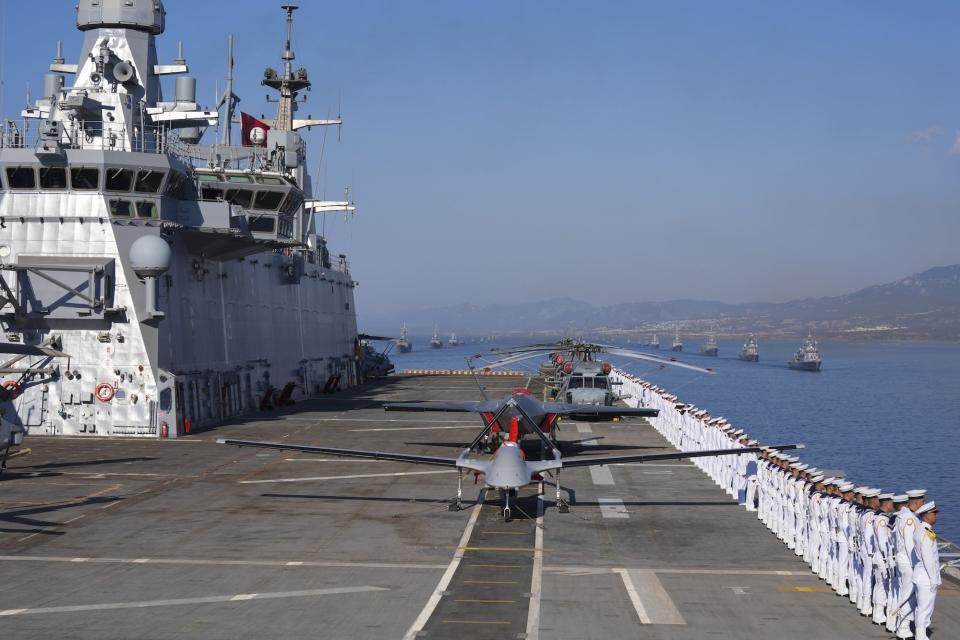-
Turkey and Iran are building aircraft carriers for drones to project naval power.
-
These drone ships offer new possibilities but are far short of the power of a traditional flattop.
-
“They will still lack the survivability of a warship, but they may be good enough,” an expert said.
Turkey and Iran say they’re building navies capable of projecting power far from their shores, and at the center of these ambitions are motherships for aerial drones.
These regional powers are betting they can build an expendable air force without the massive costs of aircraft carriers, fighter jets and pilots trained to fly them.
“I think both navies will use these carriers in the same way — to attack enemy troops and facilities ashore and enemy ships in littoral areas where they can be targeted by shore-based radar and spotters,” Bryan Clark, a naval expert at the Hudson Institute think tank, said.
Naval experts agree that drone ships represent new possibilities while pointing out that these ships fall far short of the aircraft carriers and amphibious assault ships that top navies sail. Indeed, an amphibious flattop capable of launching helicopters and short-landing and take-off jets was Turkey’s original vision, but things didn’t go according to plan.
The US banned Turkey from acquiring the F-35B, the jump-jet version of the Joint Strike Fighter it had planned to fly from the deck of its TCG Anadolu flagship. Consequently, Turkey made some modifications in the final stages of the Anadolu’s construction, ultimately transforming it into a first-of-its-kind drone carrier.
Turkey developed the Bayraktar TB3 naval drone for the Anadolu and claims the unmanned Kizilelma fighter jet it is developing could also operate from it. Ankara has plans for a second, larger vessel like the Anadolu, which it claims will have even more domestic components.
This is all part of Turkish President Recep Tayyip Erdogan’s plans for a naval force that “will protect our rights and interests in overseas impact areas on our national aircraft carrier,” as he said in an Aug. 24 speech.
Neighboring Iran has also been busy developing drone-carrying ships, which are much more makeshift than the Anadolu.
Undated imagery, most likely taken this year, showed additional construction work on Iran’s Revolutionary Guard Corp Navy’s Shahid Bagheri drone carrier, which resembles a Soviet aircraft carrier, especially with its distinctive ski jump. Unlike the Anadolu, which was a purpose-built warship from the start, the Shahid Bagheri is a modified container ship with an angled flight deck added for launching drones. It can also carry helicopters and small fast attack boats.
In May, Iran’s other drone-carrying ex-container ship, the Shahid Mahdavi, completed a 39-day voyage in the Indian Ocean. During that trip, it steamed near Diego Garcia, home to a critical American base. Iran’s IRGC gloated the voyage represented “a message to Americans that we are able to reach the closest point to you.” The IRGC also test-fired ballistic missiles from the deck of the Shahid Mahdavi in February to demonstrate the reach of its naval firepower.


‘Cheap solutions’
While nothing compared with the supercarriers of the US Navy, ships like the Shahid Bagheri and Shahid Mahdavi could still have a strategic impact.
Professor Shaul Chorev, leader of the Maritime Policy and Strategy Research Center at the Israeli National Center of Blue Economy, contrasted these DIY Iranian ships with the Israeli Navy.
“Unlike us, they use cheap solutions,” Chorev recently told Haaretz. “They take a merchant ship, equip it with a flight deck, and turn it into a poor man’s helicopter or drone carrier. It meets all their needs.”
“Ultimately, such drones — and eventually unmanned surface vessels — can be positioned at strategic points that would allow them to do what our Sa’ar 6 corvettes cannot.”
Although far from the might and versatility of flattops, these vessels enhance Turkey and Iran’s respective capabilities to project naval power.
Clark, the senior fellow at the Hudson Institute, believes these ships will “elevate” both navies by giving them “reach well beyond their own regions.”
Nevertheless, he highlighted some critical deficiencies.
“Drone carriers will not really make the Iranian Navy a blue water force because the IRIN [Islamic Republic of Iran Navy] will still lack the wide-area surveillance and targeting needed to use drones against opposing ships or the underway replenishment ships needed to keep ships at sea,” Clark told Business Insider. “Turkey’s navy has these capabilities and is already a blue-water force.”
These drone-carriers also have inherent shortcomings when compared to aircraft carriers and amphibious assault ships in other navies.
“These carriers initially will lack attributes needed in a true amphibious ship, such as a well deck or transport helicopters to deploy troops, medical facilities and berthing for troops, and repair facilities,” Clark said. “They could add some of these capabilities, though, and be a version of an amphibious ship.”
“They will still lack the survivability of a warship, but they may be good enough for the situations these countries could face against regional competitors,” Clark added.
Nor are these attempts equal. Andrew “Woody” Lewis, a retired US admiral who’s a distinguished fellow at the Center for European Policy Analysis, views Iran’s attempts at projecting naval power as second-rate compared to Turkey.
“Iran’s intent to project power far from its shores with drones from the Shahid Bagheri does not give them a capability to attain sea control in a blue water environment,” Lewis, a former US 2nd Fleet commander, told BI. “It is nothing more than an attempted terror attack in open water without the ability to hide behind surrogate forces ashore.”
“The Iranian aspirations are in no way comparable to the tremendous capabilities of the US and our Allies to reconfigure the payload of large- and medium-sized naval platforms to project power in a blue water environment,” Lewis said.
Read the original article on Business Insider







